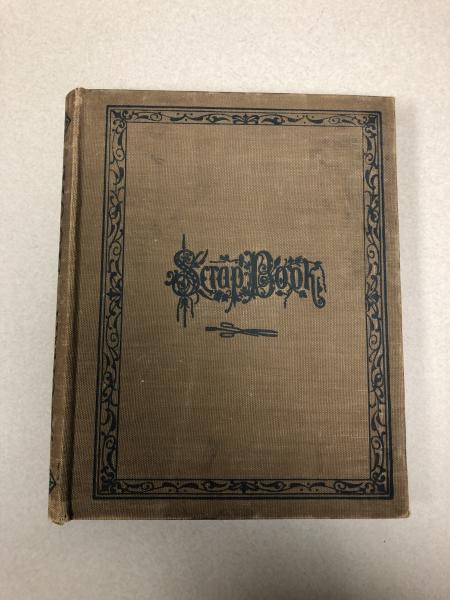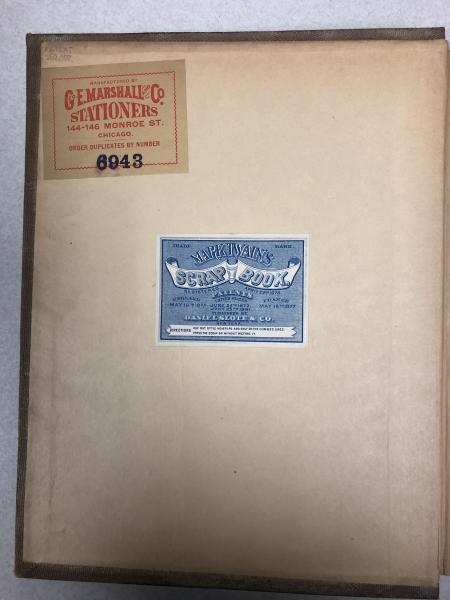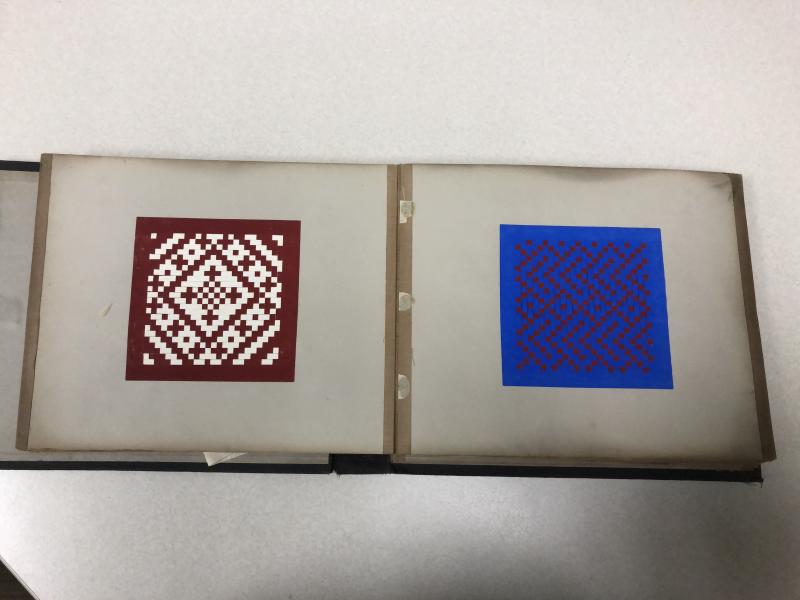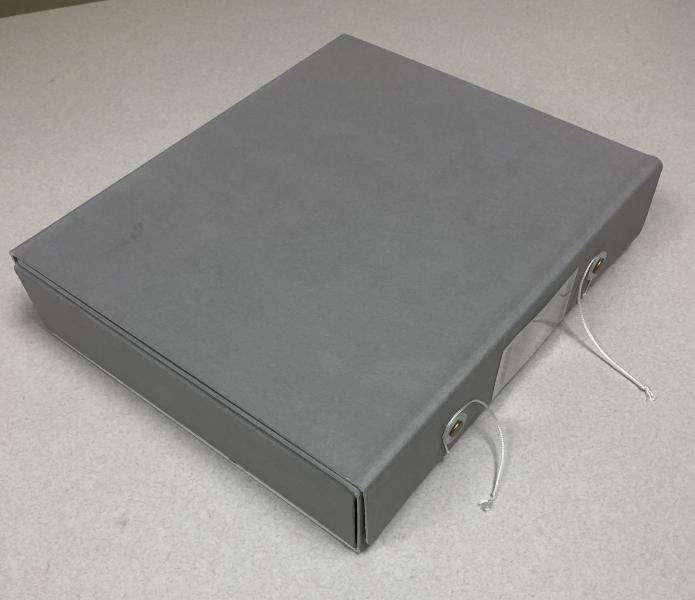Beyond the Book: Scrapbooks
Mary Burns, Special Collections Catalog Librarian, Northern Illinois University
Meghan Ryan, Special Collections and Cataloging Librarian, National Louis University
Whether it’s photographs, cards, newspaper clippings, pressed flowers, or drawings, people have been collecting materials and keepsakes in book form for centuries. Scrapbooks are unique items, as they often draw on the experiences of the creator of the scrapbook and tell a personal story.

Over the years, scrapbooks have evolved by using what materials are available to the maker. Jennifer Teper describes in her article, An Introduction to Preservation Challenges and Potential Solutions for Scrapbooks in Archival Collections, how calling cards, signatures and photographs were collected in the 1850s and by 1900, scrapbooks were introduced “as a popular format.”1

In the early 1870s, Mark Twain, also a scrapbooker, invented a self-pasting scrapbook available to consumers. Teper also explains that a heyday for scrapbooking was between 1920 and 1970.2 In the early 2000s, scrapbooking experienced a resurgence. Different materials throughout various periods of history requires varying approaches to scrapbook preservation.
Scrapbook Characteristics and Classification
While scrapbooks are unique items, they often share similar structural characteristics. As Teper notes that scrapbooks contain “a cover or binding; a text block of bound-in pages; and a unique collection of memorabilia of one or many formats that is attached to the pages of the book. Although many scrapbooks have been created using bindings and pages created exclusively for this purpose, other scrapbooks may be generated using ledgers, notebooks, or other book formats readily available.”3
Many scrapbooks have both informational and artifactual value. It is interesting to note a paper given by Sherelyn Ogden at a meeting of the American Institute for Conservation as a part of the Book and Paper specialty group session. She discusses four different groups that scrapbooks can be divided into based on their artifactual value and/or informational value.4
The first type of scrapbook contains only valuable informational content, a scrapbook of newspaper clippings being a common example. Scrapbooks in the second group have content with artifactual value, but the book itself is not valuable. This type has various kinds of memorabilia such as photographs, artwork and three-dimensional artifacts that are mounted on acidic leaves.

The third category includes scrapbooks that are valuable because of the kind of book they are and not because of their content. These scrapbooks are made from various items including old ledgers and diaries. Their value is in the original contents which may be covered up or obscured by various kinds of memorabilia. Scrapbooks in the fourth category have a high degree of artifactual value. Their contents are valuable and the book itself is valuable. In addition to containing various types of memorabilia, the book itself may have a binding created by the maker or pages with handwriting.
Conservation Challenges & Preservation Considerations
The conservation challenges that scrapbooks present are frequently daunting. Many were made using inexpensive materials so they could be mass-produced and made affordable for the general public. In addition to paper ephemera, many contain a variety of materials including newspaper clippings, badges, locks of hair, photographs, and pressed flowers.
Other conservation challenges include that the bindings can fall apart, the pages can come out, the leaves of paper or cardstock can become discolored or brittle, the memorabilia can fall off the pages, and the memorabilia itself may deteriorate. Leather scrapbook covers may deteriorate and develop red rot. Bindings can be strained when the scrapbook is too full and bulges. Pages made out of cheap wood pulp paper become acidic over time. Black scrapbook paper introduced in the 1940s can also become acidic. Memorabilia may be damaged from using the wrong types of tapes or glues. Metal paper clips and staples may rust if the scrapbook is stored in high humidity. Scrapbooks that contain pressed flowers, locks of hair and food are prone to mold and pest infestations.

Each scrapbook should be evaluated individually to determine the level of care and preservation treatment it requires. Teper relates that minor repairs can be done fairly easily but a complete conservation treatment takes many hours to accomplish.5 A scrapbook may be left as it is or rearranged. Some of its contents may need to be removed and enclosed in either archival quality folders or envelopes or encapsulated. Also, memorabilia can be removed and put in a protective enclosure and reattached to the scrapbook page.
Scrapbooks can also be preserved by digitization, microfilming or making a facsimile. Childs-Helton advises that the conservation goal should be to maintain the intellectual and artifactual integrity of the scrapbook even though the original may be unbound, duplicated, and stored in a different location.6 Many professionals prefer to keep the scrapbooks intact so their original integrity will be maintained.
However, in addition to the costs, the process of reformatting could permanently damage the scrapbook. The decision to reformat should be considered carefully. Disbinding the scrapbook for microfilming or digitization could cause permanent damage. Color scrapbooks translate poorly to bi-tonal microfilm. Pages may have multiple layers of memorabilia that require more than one frame to record the page. Creating a facsimile instead of a digital surrogate eliminates the concern about having a digital preservation program in place.
One should look to the library's collection policy for guidance on making conservation decisions. Scrapbooks may be considered an informational resource or an artifact. Characteristics to consider when deciding on the appropriate levels of conservation for a scrapbook include its uniqueness, association value, level of informational content and artistic qualities.
To slow the degree of deterioration of scrapbooks and their contents the most important points to consider are how they are handled and how they are stored. Ideally they should be stored at 65º + 2 degrees Fahrenheit or lower with relative humidity between 35 and 50 + 3 percent. Exposure to damaging light can be avoided by storing scrapbooks in archival boxes or enclosures. Scrapbooks can also be wrapped in buffered paper although they are not supported as well as they would be in an archival box. The binding of the scrapbook can be supported by a cradle when viewed by a user. Stress on the pages can be reduced by putting a lightweight cardstock underneath of them when they are being turned. Wearing gloves keeps photographic emulsions from being damaged by finger prints but can reduce dexterity resulting in pages being snagged and torn. The Library of Congress has published two leaflets that discuss best practices for creating scrapbooks today so the sorts of problems conservators grapple with today can be reduced in the future.
Images courtesy of the National Louis University Rare Book & Special Collections.
Resources
Childs-Helton, Sally. "Evaluating Scrapbooks for Preservation and Access: Information or Artifact," MAC Newsletter (July 2009)
Chirnside, Angeline. "Preserving Scrapbooks for Exhibition at Si Geoge Grey Special Collections: A Case Study of the Big OE," Archifacts (December 2015)
Library of Congress. Newsprint and Its Preservation. Preservation Leaflet No. 5. (Washington, D.C.: Library of Congress, November 1981)
Library of Congress. Preserving Your Memories: Traditional Albums and Scrapbooks. Preservation Week, April 21-27, 2013
Library of Congress. Preserving Your Memories: Traditional and Digital Scrapbooking for Preservation. Preservation Week, April 21-27, 2013.
Tedone, Melissa A. Preserving Historic Scrapbooks & Making New Ones That Last. ALCTS Webinar, May 1, 2014
Tepper, Jennifer H. "An Introduction to Preservation Challenges and Potential Solutions for Scrapbooks in Archival Collections," Journal of Archival Organization (May 2008)
Zucker, Barbara Fleisher. Preservation Basics: Preservation of Scrapbooks and Albums
Notes
1Jennifer H. Tepper, "An Introduction to Preservation Challenges and Potential Solutions for Scrapbooks in Archival Collections," Journal of Archival Organization 5, no. 3 (May 2008): 48.
2Ibid.
3Ibid., p. 50.
4Sherelyn Ogden, "Preservation Options for Scrapbooks and Album Formats." Book and Paper Group Annual 10 (1991): 149-163.
5Jennifer H. Tepper, "An Introduction to Preservation Challenges and Potential Solutions for Scrapbooks in Archival Collections," Journal of Archival Organization 5, no. 3 (May 2008): 59.
6Sally Childs-Helton, "Evaluating Scrapbooks for Preservation and Access: Information or Artifact," MAC Newsletter (July 2009): 31.
Return to Beyond the Book: Preserving your Non-Book Collections

